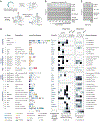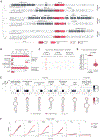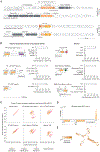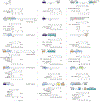Diverse enzymatic activities mediate antiviral immunity in prokaryotes
- PMID: 32855333
- PMCID: PMC7985843
- DOI: 10.1126/science.aba0372
Diverse enzymatic activities mediate antiviral immunity in prokaryotes
Abstract
Bacteria and archaea are frequently attacked by viruses and other mobile genetic elements and rely on dedicated antiviral defense systems, such as restriction endonucleases and CRISPR, to survive. The enormous diversity of viruses suggests that more types of defense systems exist than are currently known. By systematic defense gene prediction and heterologous reconstitution, here we discover 29 widespread antiviral gene cassettes, collectively present in 32% of all sequenced bacterial and archaeal genomes, that mediate protection against specific bacteriophages. These systems incorporate enzymatic activities not previously implicated in antiviral defense, including RNA editing and retron satellite DNA synthesis. In addition, we computationally predict a diverse set of other putative defense genes that remain to be characterized. These results highlight an immense array of molecular functions that microbes use against viruses.
Copyright © 2020 The Authors, some rights reserved; exclusive licensee American Association for the Advancement of Science. No claim to original U.S. Government Works.
Figures





References
-
- Suttle CA, Viruses: unlocking the greatest biodiversity on Earth. Genome 56, 542–544 (2013). - PubMed
-
- Cobián Güemes AG et al., Viruses as Winners in the Game of Life. Annu Rev Virol 3, 197–214 (2016). - PubMed
-
- Hille F et al., The Biology of CRISPR-Cas: Backward and Forward. Cell 172, 1239–1259 (2018). - PubMed
-
- Samson JE, Magadán AH, Sabri M, Moineau S, Revenge of the phages: defeating bacterial defences. Nat Rev Microbiol 11, 675–687 (2013). - PubMed
Publication types
MeSH terms
Substances
Grants and funding
LinkOut - more resources
Full Text Sources
Other Literature Sources
Research Materials

